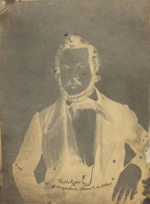Photographic Processes: 1839 – 1889
CALOTYPE (Talbotype), 1841-1850
Silver-based paper negative, or a positive printed on salted paper from the paper negative
The term “calotype” commonly refers to a paper negative, but it also refers to a positive print produced from the paper negative. Paper is coated with a solution of silver nitrate followed by a solution of potassium iodide. It is then washed and dried. The “iodized paper” is coated with a solution of silver nitrate and gallic acid and exposed in a camera while still damp. After exposure, the image is latent and is nearly or entirely invisible on the paper. A developer comprised of the same silver nitrate and gallic acid solution is used to bring out the image. When the development is complete, the paper is washed and fixed with hypo. The paper is often waxed overall or locally after the process to improve translucency. The calotype is also known as the Talbotype, after its inventor, W. H. F. Talbot.
The calotype has neutral image tone. The negative is generally stable because waxing protects it from atmospheric pollutants.
 |
Frederick and William Langenheim. Calotype Negative, 1849. [zoom] 7 5/8 x 5 7/8 in. This rare portrait of Frederick Langenheim (1809-1879) bears ink annotations, “Talbotype, W. & F. Langenheim, Phila., Mar. 5, 1849. No. 235.” The Langenheim brothers, who were among the first successful commercial photographers in the United States, pioneered several photographic advancements. On loan from the Stephan and Beth Loewentheil Family Photographic Collection. |